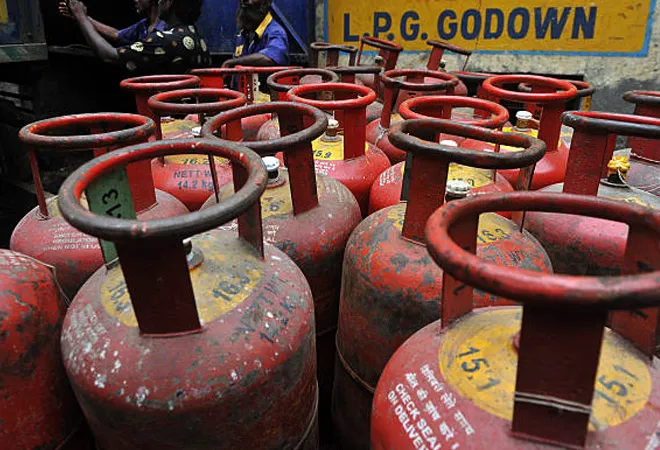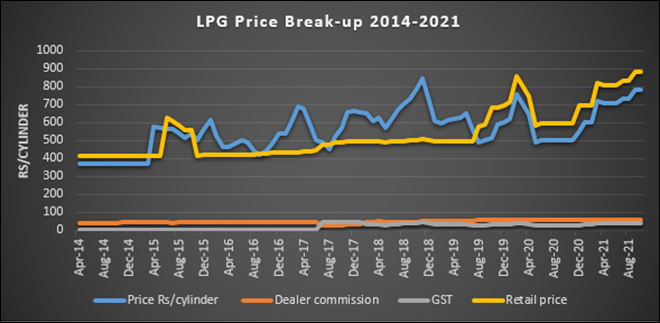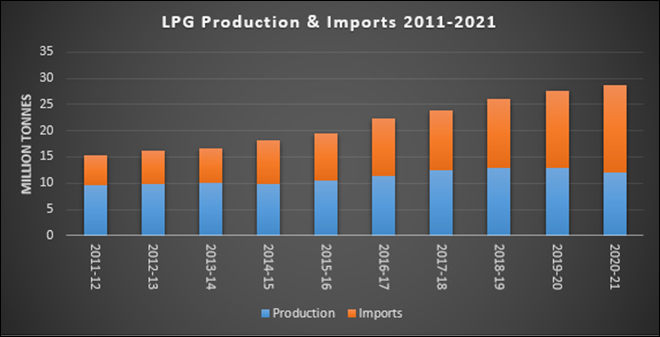
This article is part of the series Comprehensive Energy Monitor: India and the World
Status
According to the Petroleum Planning & Analysis Cell (PPAC), 99.8 percent of households In India have liquefied petroleum gas (LPG) connections based on active domestic connections and the number of estimated households. This may not be an accurate figure as it is the result of dividing the number of domestic connections by the number of households estimated by the extrapolation of census 2011 data on the number households. A simple adjustment to the projected number of households can give the desired percentage for LPG access. Notwithstanding this inaccuracy, subsidies for LPG access and consumption has remained one of the driving forces behind increase in household adoption of LPG for over four decades.
A simple adjustment to the projected number of households can give the desired percentage for LPG access.
The recent increase in the retail price of LPG and the absence of direct benefit transfer payments (DBT) for over a year suggests that LPG subsidies have been phased out quietly. However, in repose to a question in the Lok Sabha in August 2021 on whether LPG subsidy has been phased out, the Minister for Petroleum & Natural Gas (MOPNG), stated that the government continued to modulate the effective price of domestic LPG and that the subsidy on LPG depended on both the international product price and government decision. However, according to data from the PPAC, the last subsidy pay-out for domestic LPG in the form of DBT was made in July 2019. Since then, the retail price of domestic LPG is the same as the basic price plus dealer commission and GST (goods and services tax). For example, In October 2021, the price before taxes and subsidies of LPG was INR 780.52/cylinder and the retail price charged to the domestic consumer INR 884.5/cylinder that included a dealer commission of INR 61.84/cylinder and GST of INR 42.14/cylinder.
The recent increase in the retail price of LPG and the absence of direct benefit transfer payments (DBT) for over a year suggests that LPG subsidies have been phased out quietly.
Subsidy Trends
Since April 2014, the retail price of LPG has increased by almost 113 percent from INR 414/cylinder to INR 884.5/cylinder in October 2021. Under the “burden sharing” programme that was in place between December 2015 and October 2017, the largest burden (amongst oil companies) was carried by the upstream company ONGC (oil and natural gas commission) that peaked at about INR 50/cylinder in December 2015. Price support from the government (either through a price discount at the retail end or as DBT) touched a peak of INR 435/cylinder in November 2018 after which it fell to about INR140/cylinder in July 2019. After July 2019, there is no record of LPG subsidy pay-outs from the government.
 Source: Calculated from PPAC reports 2014 to 2021
Source: Calculated from PPAC reports 2014 to 2021
Subsidy Phase-out
In response to a Lok Sabha question in August 2021 as to why the retail price of LPG has remained high despite the fall in global prices, the Minister of State for Petroleum & Natural Gas offered an ambiguous response that did not explicitly state that subsidies to LPG have been withdrawn. Other responses by the representatives of the Government to questions over the price of LPG at the Lok Sabha or through media outlets focussed on assigning blame on the increase in international price of LPG. Though the international price of LPG has started to increase after the end of the pandemic-related lockdowns, the price was falling in the previous six years. Between 2013-14 (financial year) and 2019-20, the international price of LPG fell by 48 percent and between 2013-14 and 2020-21, it fell by about 31 percent. The retail price of LPG increased by over 110 percent between April 2014 and October 2021. The international price of LPG matters as the share of LPG imports in total LPG consumption has increased from about 37 percent in 2011-12 to over 57 percent in 2020-21.
Though the international price of LPG has started to increase after the end of the pandemic-related lockdowns, the price was falling in the previous six years.
Between 2013-14 and 2015-16, government subsides under the burden sharing programme fell by over 64 percent from INR 746.1 billion to 263 billion and oil company share fell by over 98 percent from INR691.28 billion to about INR12.68 billion. DBT pay-out fell by over 86 percent from INR275.7 billion in 2015-16 to about INR36.58 billion in 2020-21.
Issues
The government has taken credit both for reducing LPG subsidies for the rich and for introducing LPG subsidies for the poor under the ‘Pradhan Mantri Ujjwala Yojana’ (PMUY) scheme. But both claims are contested. In 2016, the government claimed that it has reduced LPG subsidy burden through the “give it up” scheme, though only about 5 percent of households voluntarily opted out of LPG subsidies. More significantly the CAG (comptroller auditor general) discredited the claim, observing that though the decrease in the offtake of subsidised LPG cylinders made a small contribution, fall in crude prices was by far the main factor in reducing LPG subsidies. The CAG also pointed out inconsistencies in the methodologies adopted by the Ministry of Petroleum & Natural Gas and oil companies to estimate savings from reduction of LPG subsidies.
According to many early studies, the PMUY scheme did not result in widespread adoption of LPG in poor households as the primary cooking fuel. The scheme was short-term oriented with one-time subsidies that targeted voters in poll bound states. Spending on PMUY fell by more than 50 percent from INR29.9 billion in 2015-16 to about INR12.93 billion in 2019-20. As there was no improvement in incomes of households receiving LPG connections under PMUY, they were unable to purchase replacement cylinders. Phasing out of subsidies for LPG has made it even more difficult for PMUY recipients to purchase refill cylinders. This often means reverting to burning biomass. Giving poor households LPG connections is one step but for meaningful energy transformation poor households must be enabled to modernise, industrialise and urbanise so that they no longer need government subsidy programmes for LPG access.
The CAG also pointed out inconsistencies in the methodologies adopted by the Ministry of Petroleum & Natural Gas and oil companies to estimate savings from reduction of LPG subsidies.
Distributing public goods such as access to energy (LPG connections or electricity) as private transfers to individual citizens (voters) as the means to secure votes rather than providing broad-based services to which many would simultaneously have access used to be called populism. Now the same is recast in positive light as “new welfarism” and celebrated for its environmental and health benefits. The rationale is that LPG access reduces use of biomass in households and consequently eliminates smoke that affects the lungs of women who spend time in smoke filled rural kitchens. If there is genuine long-term concern over the environment and women’s health, it is important that energy access programmes do not become means for political ends. For this the politician needs to see beyond elections and budgetary provisions look beyond electoral cycles.
 Source: Calculated from PPAC reports 2011 to 2021
Source: Calculated from PPAC reports 2011 to 2021
The views expressed above belong to the author(s). ORF research and analyses now available on Telegram! Click here to access our curated content — blogs, longforms and interviews.






 PREV
PREV




